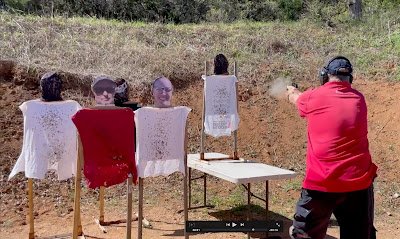In the video linked below a store owner reacts to three thugs attempting a robbery. The thugs enter the store and immediately threaten the owner and customers with firearms. The thugs are committing aggravated robbery and threatening the use of unlawful deadly force—both acts are serious felonies. (see video)
At one point the store owner has retreated and a thug is on the counter threatening him with a pistol. The store owner cooperates until he has the opportunity to retrieve his pistol. We next see the store owner after he has returned to the front and grabbed a pistol from under the counter. He opens fire on the three thugs and at least one returns fire as they scramble to escape out the front door.
The thugs then exit the store and the owner pursues. Pursuing the thugs is a bad decision as this creates a second event distinct from the earlier aggravated robbery. The owner is now using deadly force against the thugs who arguably no longer pose the threat of unlawful deadly force. As of this writing, there is no indication that the store owner has been charged.
The store owner’s pursuit of the thugs however, does provide a prosecutor the opportunity to charge the store owner with aggravated assault. If he had not pursued the robbers into the street, the prosecution would have faced an almost impossible burden in attempting to disprove any claim of self-defense or defense of other innocents (there were at least three customers in the store). This would have made the store owner extremely hard to convict and prosecutors do not like taking cases to trial that are hard to convict. Do not chase escaping thugs.
We used this incident as a basis for a Short Range Match stage. The Short Range Match safely replicates real-life incidents on the range which then allows competitors to solve the problem. All threat targets have a visible weapon or full mask distinguishing them from the non-threats who have no visible weapon and their face is not covered. In this particular stage, we had the competitors fire the stage three times (strings of fire) beginning from three different start positions: hand on pistol, hands at sides, and hand in surrender with wrists above shoulder.
 |
| Eric Shooting the Short Range Stage |
The stage is set with two non-threats in front of the threat targets and one threat standing on the counter as you will see in the video. My string for the stage shown in the video is with me using a P365 (I am an IDPA Master with the Back Up Gun) and starting with my hand on the pistol. My draw time measured from the instant I initially moved at the start signal until I fired the first shot was 0.63 seconds. This measurement does not include my reaction to the buzzer. As a point of interest, the buzzer’s “beep” lasts 0.30 seconds and I reacted to the onset of the beep in 0.20 seconds. My draw from concealment starting from hands at sides was 1.77 seconds and my draw from surrender was 1.67 seconds.
Another IDPA Master shooter using a Carry Optic measured in the same manner resulted in a 1.10 second draw with hand on pistol, from hands at sides was 1.30 seconds, and his draw from surrender was 1.60 seconds.
I’ve collected data on literally thousands of runs comparing these starting positions and (depending upon the shooter’s skill) starting with the hand on the pistol saves 0.50 – 1.75 seconds or more over starting with your hand on the pistol versus starting with the hands in another position. Clearly, if you see a potentially unlawful deadly force incident developing, placing your hand on your pistol can save significant time on your draw.
If you enjoy reading these please subscribe. The link is on the upper right side of the page. All that will happen is that you will receive an e-mail when I post an article. Your information will never be distributed.

No comments:
Post a Comment